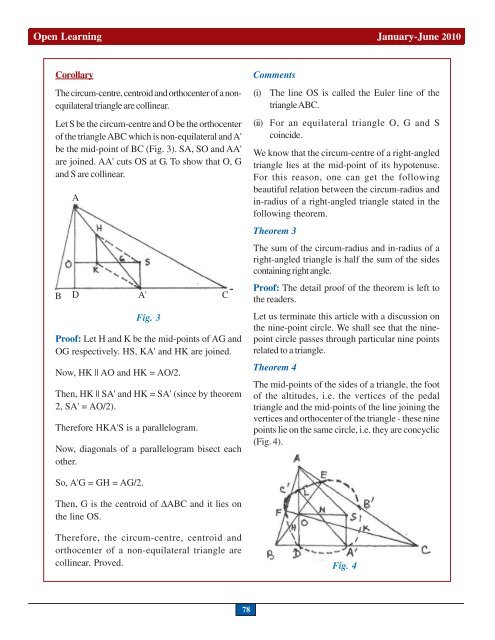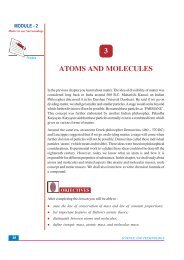Open Learning Jan-June -2010 - An Awareness Magazine
Open Learning Jan-June -2010 - An Awareness Magazine
Open Learning Jan-June -2010 - An Awareness Magazine
Create successful ePaper yourself
Turn your PDF publications into a flip-book with our unique Google optimized e-Paper software.
eqDr <strong>Open</strong> f'k{kk <strong>Learning</strong> <strong>Jan</strong>uary-<strong>June</strong> tuojh&twu <strong>2010</strong><br />
Corollary<br />
The circum-centre, centroid and orthocenter of a nonequilateral<br />
triangle are collinear.<br />
Let S be the circum-centre and O be the orthocenter<br />
of the triangle ABC which is non-equilateral and A'<br />
be the mid-point of BC (Fig. 3). SA, SO and AA'<br />
are joined. AA' cuts OS at G. To show that O, G<br />
and S are collinear.<br />
A<br />
B D A' C<br />
Fig. 3<br />
Proof: Let H and K be the mid-points of AG and<br />
OG respectively. HS, KA' and HK are joined.<br />
Now, HK || AO and HK = AO/2.<br />
Then, HK || SA' and HK = SA' (since by theorem<br />
2, SA' = AO/2).<br />
Therefore HKA'S is a parallelogram.<br />
Now, diagonals of a parallelogram bisect each<br />
other.<br />
Comments<br />
(i)<br />
The line OS is called the Euler line of the<br />
triangle ABC.<br />
(ii) For an equilateral triangle O, G and S<br />
coincide.<br />
We know that the circum-centre of a right-angled<br />
triangle lies at the mid-point of its hypotenuse.<br />
For this reason, one can get the following<br />
beautiful relation between the circum-radius and<br />
in-radius of a right-angled triangle stated in the<br />
following theorem.<br />
Theorem 3<br />
The sum of the circum-radius and in-radius of a<br />
right-angled triangle is half the sum of the sides<br />
containing right angle.<br />
Proof: The detail proof of the theorem is left to<br />
the readers.<br />
Let us terminate this article with a discussion on<br />
the nine-point circle. We shall see that the ninepoint<br />
circle passes through particular nine points<br />
related to a triangle.<br />
Theorem 4<br />
The mid-points of the sides of a triangle, the foot<br />
of the altitudes, i.e. the vertices of the pedal<br />
triangle and the mid-points of the line joining the<br />
vertices and orthocenter of the triangle - these nine<br />
points lie on the same circle, i.e. they are concyclic<br />
(Fig. 4).<br />
So, A'G = GH = AG/2.<br />
Then, G is the centroid of ΔABC and it lies on<br />
the line OS.<br />
Therefore, the circum-centre, centroid and<br />
orthocenter of a non-equilateral triangle are<br />
collinear. Proved.<br />
Fig. 4<br />
78
















